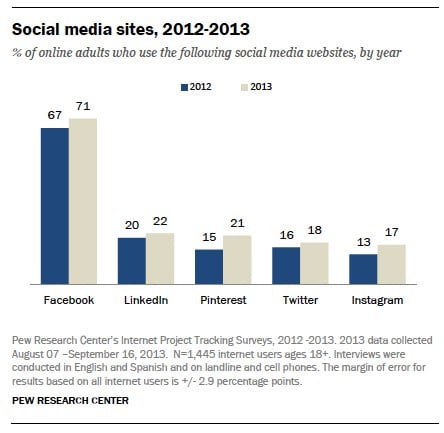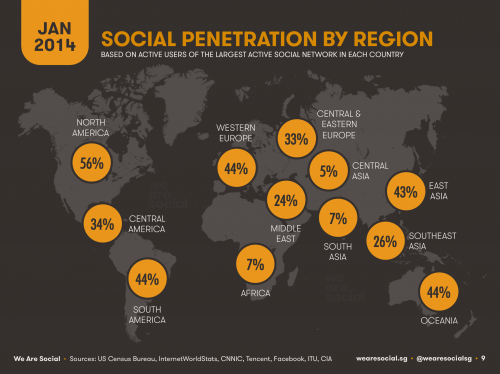
 Why is digital advocacy important for nonprofits?
Why is digital advocacy important for nonprofits?Donations and soliciting volunteers are just two forms of support that nonprofit organizations can build online, but narrowly focusing on these two may cause a nonprofit to miss the true opportunities available to them online.
42% of online adults use multiple social networking sites - Pew Research -2013 surveys
Support comes in many shapes and sizes. Online, a nonprofit's story can find an audience, and that audience can share that story many time over. This is a form of support that we call digital advocacy. It can have a profound affect on a nonprofit.
Now, with the web at 25 years old, users are hyper-connected. We connect, communicate and share on a variety of devices and social networks with friends, family and strangers.
According to a study by Georgetown University’s Center for Social Impact Communication and Waggener Edstrom in Harness Social Media for Social Good:
56% of those that support nonprofits on the Social Web confirm that compelling storytelling is what motivates them to take action on behalf of nonprofits.
Each cause and organization may have a unique formula for social engagement. Facebook is still a lead platform, but this does not mean that Facebook is a must for all organizations. It's best to understand your organization's advocates, supporters, influencers and champions.
55% of those who engage with nonprofits via social media have been inspired to
take further action.
Above: Also from the Georgetown University’s Center for Social Impact Communication and Waggener Edstrom report.
However, having an understanding of the marketplace also can shape resource allocations for nonprofit marketing.

North American social media penetration rates are at 56% according to the US Census Bureay, InternetWorldStats, CNNIC, Facebook, ITU and data from other contributors. Top social networks added more than 135 million new users in the course of 2013.

Mobile penetration in North America is 101%, which means there are more mobile phones that people. The opportunities with mobile are great for nonprofits, and should be considered alongside a more traditional web and social strategy. Yet, 84% of non profit donation landing pages are not optimized for mobile.
Digital advocacy can provide visibility to a nonprofit, it's cause, it's story and it's mission. Within the heart of digital advocacy is peer-driven recommendations and endorsements. These endorsements can be made through social media, blogs, email, links to a non profit's website or other forms of online sharing. They are powerful, and can influence all forms of giving and support. Digital advocacy builds relevance for a nonprofit organization.
Also... there are benefits to a fundraiser:
In 2012, Mashable examined how nonprofit organizations adopted social media. The results were astonishing. For example, Sam Laird, a writer for Mashable, by integrating Twitter into an organization's social media practice fundraising was reported to have grown by almost ten times.
Access and penetration: from social to mobile
Social media can provide powerful access for nonprofits to audiences and influencers. Social media penetration rates are climbing, which helps drive the potential for online and digital advocacy.
Social endorsements act as a testament to worthiness
As users share an organization’s content, this form of endorsement helps to build awareness within peer groups. However the benefits are not limited to peer-based network sharing either. Social sharing can have a residual effect on search ranking and the traffic an organization receives from search engines. Sharing can also help to raise the profile of a nonprofit within the competitive space that all organization’s compete. Ultimately these endorsements can be persuasive to other potential supporters as both a reminder of the cause and a testament to the cause’s worthiness.
Retention and nurturing.
The retention rate of first year donors is 23.7% according to Blackbaud's report Reactivating Lapsed Donors. Nonprofit organizations have a healthy base of prospects to recapture.
Great content that is high sharable makes advocacy easier. Targeted promotions and social endorsements also provide amplification to a message. Social endorsements and advocacy helps to solidify this agreement and bond between a cause and a giver. It reinforces their connection, especially if shared within peer groups.
Further reading:
by Jonathan Franchell, CEO of Ironpaper - For more tips and hacks: Need to remove a new line after h1 tags? Both web designers and SEO practitioners need to employ headline tags: H1, H2, H3 in several ways to improve web page structure and tag...

The Crowded Arena of the IT Marketplace Updated December 2024 The Information Technology (IT) landscape is experiencing rapid growth and intensifying competition. IT spending is projected to reach nearly 5.1 trillion U.S. dollars in 2024, a...

Updated December, 2024 The field of digital marketing is evolving rapidly in response to new technology and changing buyer expectations. To help career-minded marketers, we’ve rounded up the top 10 skills needed to succeed in the field. These are...

The marketing industry is transforming significantly due to generative AI and increasing market complexity. Gartner's prediction of a 25% decline in traditional search traffic suggests that the era of search engines is dying. AI tools, particularly...
